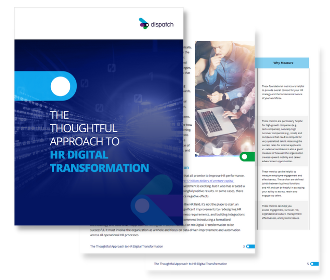Kronos and Workday Integration for Global Asset Management Firm
Client
US-based commercial property development and real estate management firm
Challenge
Our client is a global asset management firm undergoing substantial growth – both organically and through acquisition. They recently acquired a nation-wide property development company and initiated a project to consolidate both organizations’ core HR processes in Workday.
As a part of this process, our client decided to modernize its time & attendance systems on a single new instance of Kronos Workforce Dimensions. Thousands of employees from both organizations would be impacted by the change. Given the nature of their business, these employees were distributed across the US.
Dispatch was asked to build the integrations and workflow automation processes between Kronos and Workday as part of a larger post-acquisition HRIS integration project.

Approach
Time and Attendance projects are critically important. Time entries drive payroll, and any mistakes can be extraordinarily costly and disruptive to the employees affected. In this case, Kronos was new to both organizations and was part of a larger project that introduced changes in systems and processes in HR, payroll, benefits management, and more. These projects are time-boxed because changes in payroll need to happen at the start of a year (or at least, at the beginning of a quarter) for accounting purposes. That made this a multi-dimensional project with a critical launch window that could not be missed.
We de-risk our projects by running a comprehensive discovery process as a component of our DIVE project methodology to ensure all stakeholders understand the current processes and future-state business requirements. Discovery is very detailed, down to the field mapping level to eliminate ambiguity about what’s being built and how data needs to flow between applications. Through this process, we also work through several scenarios and use-cases involving subsets of the population that require different processes and data. In our client’s case, there were several collective bargaining agreements in play, plus non-unionized, salaried, and contractor populations, each with unique time & attendance rules that needed to be incorporated in the solution. Some states, such as California, also have specific regulations regarding pay compliance and reporting that need to be included in any payroll solution.
We involve subject matter experts in both organizations through this process, plus Kronos and Workday experts to ensure we understand precisely how Workday is configured and what’s needed to configure Kronos appropriately. Our role is central – each expert knows their own application and function, and we help build a comprehensive solution design that spans systems, business functions, and organizations.
Development is done using agile sprints, with frequent check-ins with the business teams. We recognize that discovery is vital, but it will never be perfect, and demos during development are extremely valuable to get feedback and have both the business and developers undergo rapid learning cycles, so we all converge on the right solution.
Comprehensive validation of the solution is essential and is especially necessary to test whether each sub-population and use-case requirements are addressed. We develop test cases during discovery to ensure we have adequate validation coverage and conduct testing throughout the entire project. We also work with business teams during formal User Acceptance Testing to ensure they have the tools, access, skills, and time to complete acceptance testing and build confidence in the solution.
Solution
We built a demographic outbound integration from Workday to Kronos using Workday’s built-in integration platform to ensure Kronos was always in sync regarding the employee population. This was done using a core connector worker and document transform pattern. We also built absence balance and payroll input integrations to move this data from Kronos back to Workday, using Workday’s Studio integration development environment.
An important architectural choice is whether Kronos or Workday is the system of truth for certain types of data. In this case, it made sense for Kronos to be the primary data source for time off balances. With other clients, we have seen Workday as this source. The choice is dependent on several factors, including the desired user experience for employees and managers regarding time off management. With Kronos as the system of truth for time off data, the logic regarding time off accruals and management for the various pay groups (unions, non-union hourly, salary, etc.) needed to be built and managed in that system.
A critical component of time & attendance integrations is ensuring data flows between the systems are always accurate and meet regulatory compliance requirements. For instance, California requires paystubs to include details regarding time-off accrued and taken since the last pay – not just accumulated balances. This requires transactional data to be transferred to Workday from Kronos and additional logic to validate this data prior to incorporating it into paystubs. It also meant a significant amount of data to be synced – dozens of transaction records times thousands of employees each week.
Another factor to consider is how the business processes and integrations handle employee mobility between different business units. Because of the large number of subpopulations with different pay and time off rules, the integration needed to include logic to determine employee eligibility. It is quite common for employees to change roles and pay groups throughout their employment lifecycle, which impacts how their data is processed between systems. If the integration doesn’t account for this, payroll files could be generated based on incorrect data and calculations – which is very disruptive and costly.
Field mapping can be a complicated exercise between Kronos and Workday. Mapping is dependent on how each application is configured, the populations in scope and their contractual rules, and business requirements for general ledger accounting and reporting. Fields can be mapped one-to-one or many-to-one, but sometimes one-to-many field mapping scenarios occur (where one field in Kronos could be mapped to various Workday values). The integration needs to have sufficient logic to determine how to handle one-to-many field mapping scenarios based on other demographic and transactional fields. How pay components are configured also dictates mapping. Experts in each system as well as payroll and reporting business process experts must be part of this mapping process.
Kronos doesn’t just track hours; it also tracks dollars and “unit” codes. How these codes map to Workday and what logic is used behind each code is crucial to understand. The business process relies on calculated fields based on these attributes, so they must be correct.
Outcome
This project was completed on-time and under budget, and the time & attendance management for the populations of both organizations were successfully migrated to Kronos. The integrations proved robust and built confidence in payroll accuracy right from the first pay run. We have subsequently fine-tuned elements of the integration related to employee eligibility and compliance functions, and these are typical aspects of integration continuous improvement.
CASE STUDIES
Results that Matter
Start your assessment
Dispatch Integration has built HR data integrations and workflow automations for companies worldwide. Learn how we can help unlock the full potential of your HR app ecosystem.





